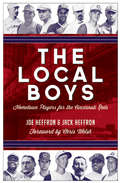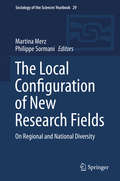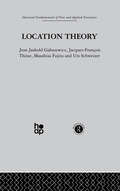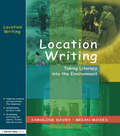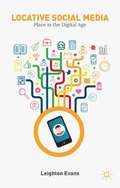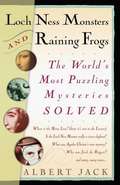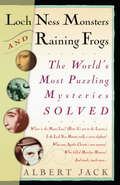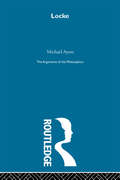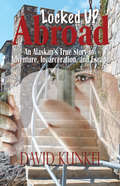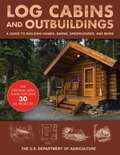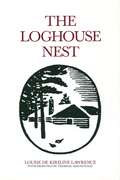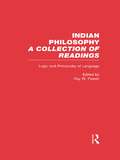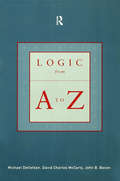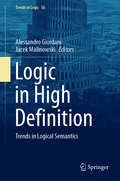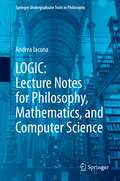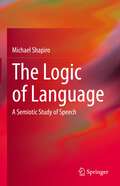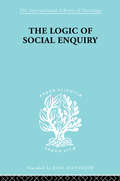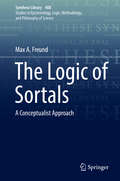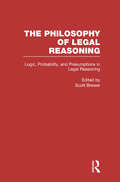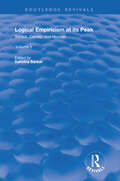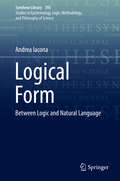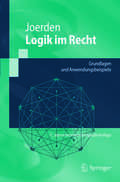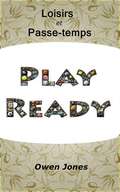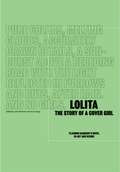- Table View
- List View
The Local Boys
by Joe Heffron Chris Welsh Jack HeffronThe Local Boys tells the stories of men who achieved the boyhood dream of playing for the hometown team. From Ethan Allen to Don Zimmer, they're all here, including Charlie "Bushel Basket" Gould, who played on the first team in 1869 to Junior Griffey, soon to be a first-ballot Hall of Famer. Alongside big-name stars like Dave Parker and Buddy Bell, fans will find those like Eddie Hunter, who played only one inning in 1933, never got to bat, and never fielded a ball. Every player receives a one- or two-page profile, many of which are based on original interviews with the players or surviving family members. Going beyond statistics, each profile brings the player to life through stories that have never before been told in print. An indispensible look at Cincinnati baseball history, The Local Boys makes an ideal gift for any Reds fan.
The Local Configuration of New Research Fields
by Martina Merz Philippe SormaniThis new Yearbook addresses the question of how policy, place, and organization are made to matter for a new research field to emerge. Bringing together leading historians, sociologists, and organizational researchers on science and technology, the volume answers this question by offering in-depth case studies and comparative perspectives on multiple research fields in their nascent stage, including molecular biology and materials science, nanotechnology, and synthetic biology. The Yearbook brings to bear the lessons of constructivist ethnography and the "practice turn" in Science and Technology Studies (STS) more broadly on the qualitative, comparative, and critical inquiry of new research fields. In doing so, it offers unprecedented insights into the complex interplay of national research policies, regional clusters, particular research institutions, and novel research practices in and for any emerging field of (techno-)science. It systematically investigates national and regional differences, including the variable mobilization of such differences, and probes them for organizational topicality and policy relevance.
Location Theory
by J. GabszewiczAnalyses the economic theory of urban land use in both its positive and normative aspects.
Location Writing: Taking Literacy into the Environment
by Brian Moses Caroline DaveyFirst Published in 2004. Routledge is an imprint of Taylor & Francis, an informa company.
Locative Social Media
by Leighton EvansLocative Social Media offers a critical analysis of the effect of using locative social media on the perceptions and phenomenal experience of lived in spaces and places. It includes a comprehensive overview of the historical development of traditional mapping and global positioning technology to smartphone-based application services that incorporate social networking features as a series of modes of understanding place. Drawing on users accounts of the location-based social network Foursquare, a digital post-phenomenology of place is developed to explain how place is mediated in the digital age. This draws upon both the phenomenology of Martin Heidegger and post-phenomenology to encompass the materiality and computationality of the smartphone. The functioning and surfacing of place by the device and application, along with the orientation of the user, allows for a particular experiencing of place when using locative social media termed attunement, in contrast to an instrumentalistconception of place.
Loch Ness Monsters and Raining Frogs: The World's Most Puzzling Mysteries Solved
by Albert JackFOOLED BY FABLES? LED ON BY LEGENDS? MYTH-GUIDED? WONDER NO MORE, MYSTERY-PHILES: THE TRUTH IS IN HERE! What in the world (or out of it) made those giant crop circles? Did skydiving skyjacker D. B. Cooper really get away with it? Is Bigfoot a big fake? Are ETs just BS? If you're tired of scratching your head over persistent puzzlers like these, mystery-buster Albert Jack has the cure for your quizzical itch. He's gone hunting for the truth behind more than thirty of the most famous and baffling conundrums in history. Did a conspiracy or a calamity kill Marilyn Monroe? Is the Bermuda Triangle a tropical tall tale? Was a dead Paul McCartney replaced by a doppelgänger? How did Edgar Allan Poe meet his doom? In quick-witted entries on each enigmatic topic, Loch Ness Monsters and Raining Frogs offers answers certain to surprise, enlighten, amuse, and perhaps disappoint true believers. But Albert Jack never fails to fascinate and entertain as he spills the beans about the odd, the eerie, and the (no longer) unexplained.
Loch Ness Monsters and Raining Frogs: The World's Most Puzzling Mysteries Solved
by Albert Jack Sandra HowgateThe world's strangest questions answered: What happened to the Mary Celeste? Where is the Mona Lisa? (clue: it's not in the Louvre) Is the Loch Ness Monster really a circus elephant? Will the real Paul McCartney please stand up? Who killed Marilyn Monroe? What was Agatha Christie's own mystery? Why does it rain frogs? Does Bigfoot exist? How did D. B Cooper get away with the perfect crime? and many, many more. With enough entertaining information to fuel hundreds of pub conversations, fascinating illustrations and all kinds of discoveries to surprise even the most expert conspiracy theorist, Loch Ness Monsters and Raining Frogs is the perfect present for anybody who's ever wondered whyhellip;
Locke-Arg Philosophers (Arguments Of The Philosophers Ser. #12)
by Michael AyersFirst published in 1999. Routledge is an imprint of Taylor & Francis, an informa company.
Locked Up Abroad: An Alaskan's True Story of Adventure, Incarceration, and Escape.
by David KunkelLocked Up Abroad is a true story of a young drug dealer and his friend turned smugglers. His shoe-string caper covered 6,000 miles from Europe to Afghanistan to Greece. The high of quick money morphed into capture. A Corrupt judicial system introduced them to a hellish 200-year-old island prison fortress. The only way out of the this devil's den was escape. Locked Up Abroad is a convincing statement of the perils of illegal drugs and unlawful activity. Only the author escaped. His companions either died in prison or are still doing time.
Log Cabins and Outbuildings: A Guide to Building Homes, Barns, Greenhouses, and More
by The United States Department of AgricultureHomesteading is a lifestyle that people around the world gravitate toward—and for good reason. In today&’s high-stress world, many people dream of heading off to their own cabin in the woods or to their large rural oasis to escape the anxieties and complexities of daily life, to live in a more natural state. Others have embraced the agricultural lifestyle of farming as a career, serving as fundamental contributors to sustaining society. With this classic guide from the US Department of Agriculture (USDA), learn about the architecture of rural life and the design elements of these amazing structures. This manual, originally published and distributed in 1972, includes government-issued designs and requirements for log cabins, farmhouses, firepits and barbecues, greenhouses, storage sheds, stables, and more! Black-and-white diagrams and illustrations fill these pages, displaying the intricacies and dimensions of these incredible structures in their entirety. Brimming with ideas and inspiration, Log Cabins and Outbuildings is the perfect starting point for building your new rural retreat.
The Loghouse Nest
by Louise De LawrenceA charming account of the author’s special relationship with the birds and wild creatures who shared her northern homesite at Pimisi Bay, near Mattawa, Ontario. The Loghouse Nest is another Natural Heritage classic by Canada’s internationally acclaimed nature writer, Louise de Kiriline Lawrence. Delightfully illustrated throughout by no less than Thoreau MacDonald, with endpaper drawings by the author.
Logic and Language: Indian Philosophy (Problems Of Philosophy Ser. #Vol. 2)
by Roy PerrettFirst published in 2001. Routledge is an imprint of Taylor & Francis, an informa company.
Logic from A to Z: The Routledge Encyclopedia of Philosophy Glossary of Logical and Mathematical Terms
by John B. Bacon Michael Detlefsen David Charles McCartyFirst published in the most ambitious international philosophy project for a generation; the Routledge Encyclopedia of Philosophy.Logic from A to Z is a unique glossary of terms used in formal logic and the philosophy of mathematics.Over 500 entries include key terms found in the study of:* Logic: Argument, Turing Machine, Variable* Set and model theory: Isomorphism, Function* Computability theory: Algorithm, Turing Machine* Plus a table of logical symbols.Extensively cross-referenced to help comprehension and add detail, Logic from A to Z provides an indispensable reference source for students of all branches of logic.
Logic in High Definition: Trends in Logical Semantics (Trends in Logic #56)
by Alessandro Giordani Jacek MalinowskiThis volume clusters together issues centered upon the variety of types of intensional semantics. Consisting of 10 contributions, the volume is based on papers presented at the Trends in Logic 2019 conference. The various chapters introduce readers to the topic, or apply new types of logical semantics to elucidate subtleties of logical systems and natural language semantics.The book introduces hyperintentional systems that aim at solving some open philosophical problems. Specifically, the first three studies focus on relating semantics, while the following ones discuss fundamental issues related to hyper-intensional semantics or develop hyper-intensional frameworks to address issues in modal, epistemic, deontic and action logic. Authors in this volume present original results on logical systems but also extend beyond this by offering philosophical considerations on the topic as well. This volume will appeal to students and researchers in the field of logic.
LOGIC: Lecture Notes for Philosophy, Mathematics, and Computer Science (Springer Undergraduate Texts in Philosophy)
by Andrea IaconaThis textbook is a logic manual which includes an elementary course and an advanced course. It covers more than most introductory logic textbooks, while maintaining a comfortable pace that students can follow. The technical exposition is clear, precise and follows a paced increase in complexity, allowing the reader to get comfortable with previous definitions and procedures before facing more difficult material. The book also presents an interesting overall balance between formal and philosophical discussion, making it suitable for both philosophy and more formal/science oriented students. This textbook is of great use to undergraduate philosophy students, graduate philosophy students, logic teachers, undergraduates and graduates in mathematics, computer science or related fields in which logic is required.
The Logic of Language: A Semiotic Study of Speech
by Michael ShapiroThis book serves as a basis for the exploration of language in a more systematic way. By surveying the several major divisions of language (phonology, morphology, syntax, lexis, tropology) and explicating the way in which sound and meaning cohere in them, this text lays bare––for students, scholars and advanced readers alike––the lineaments of an understanding of what makes language the sign system par excellence, in the service of its most important function as the instrument of cognition and of communication. This book is intended as a companion volume to Shapiro’s The Speaking Self: Language Lore and English Usage. The two volumes taken in tandem will provide a solid grounding in the observational science of linguistics, linking theory with practice in a way that will expand one’s understanding of language as a global phenomenon.
The Logic of Social Enquiry (International Library of Sociology)
by Quentin GibsonThis comprehensive set introduces the fundamental principles of Sociology as propounded by such great figures as Gerth and Mills, Schlesinger, and Homans. Containing classic works of social theory and empirical research, volumes in this set bring together the British, European and American traditions. The whole body of sociological theory is presented in such a way that is valuable and accessible to both students and teachers of Sociology, Political Theory and Geography.
The Logic of Sortals: A Conceptualist Approach (Synthese Library #408)
by Max A. FreundSortal concepts are at the center of certain logical discussions and have played a significant role in solutions to particular problems in philosophy. Apart from logic and philosophy, the study of sortal concepts has found its place in specific fields of psychology, such as the theory of infant cognitive development and the theory of human perception. In this monograph, different formal logics for sortal concepts and sortal-related logical notions (such as sortal identity and first-order sortal quantification) are characterized. Most of these logics are intensional in nature and possess, in addition, a bidimensional character. That is, they simultaneously represent two different logical dimensions. In most cases, the dimensions are those of time and natural necessity, and, in other cases, those of time and epistemic necessity. Another feature of the logics in question concerns second-order quantification over sortal concepts, a logical notion that is also represented in the logics. Some of the logics adopt a constant domain interpretation, others a varying domain interpretation of such quantification. Two of the above bidimensional logics are philosophically grounded on predication sortalism, that is, on the philosophical view that predication necessarily requires sortal concepts. Another bidimensional logic constitutes a logic for complex sortal predicates. These three sorts of logics are among the important novelties of this work since logics with similar features have not been developed up to now, and they might be instrumental for the solution of philosophically significant problems regarding sortal predicates. The book assumes a modern variant of conceptualism as a philosophical background. For this reason, the approach to sortal predicates is in terms of sortal concepts. Concepts, in general, are here understood as intersubjective realizable cognitive capacities. The proper features of sortal concepts are determined by an analysis of the main features of sortal predicates. Posterior to this analysis, the sortal-related logical notions represented in the above logics are discussed. There is also a discussion on the extent to which the set-theoretic formal semantic systems of the book capture different aspects of the conceptualist approach to sortals. These different semantic frameworks are also related to realist and nominalist approaches to sortal predicates, and possible modifications to them are considered that might represent those alternative approaches.
Logic, Probability, and Presumptions in Legal Reasoning: A Collection Of Essays By Philosophers And Legal Scholars: Logic, Probability, And Presumptions In Legal Reasoning (Philosophy of Legal Reasoning: A Collection of Essays by Philosophers and Legal Scholars #No. 1)
by Scott BrewerAt least since plato and Aristotle, thinkers have pondered the relationship between philosophical arguments and the "sophistical" arguments offered by the Sophists -- who were the first professional lawyers. Judges wield substantial political power, and the justifications they offer for their decisions are a vital means by which citizens can assess the legitimacy of how that power is exercised. However, to evaluate judicial justifications requires close attention to the method of reasoning behind decisions. This new collection illuminates and explains the political and moral importance in justifying the exercise of judicial power.
Logical Empiricism at Its Peak: Schlick, Carnap, and Neurath (Science And Philosophy In The Twentieth Century: Basic Works Of Logical Empiricism Ser. #2)
by Sahotra Sarkar Rudolf Carnap Maria Neurath Moritz SchlickFirst Published in 1996. This volume reprints pieces from the Vienna Circle period between the manifesto and the adoption of semantics, as well as two commentaries. During this period, the logical empiricists were the most ambitious and the most confident about the success of their enterprise. The first section consists of four ideological classics, The second section reprints three papers on physicalism. The third section consists of three papers on logic and the fourth on reprints three papers on truth, induction, and confirmation.
Logical Form: Between Logic and Natural Language (Synthese Library #393)
by Andrea IaconaLogical form has always been a prime concern for philosophers belonging to the analytic tradition. For at least one century, the study of logical form has been widely adopted as a method of investigation, relying on its capacity to reveal the structure of thoughts or the constitution of facts. This book focuses on the very idea of logical form, which is directly relevant to any principled reflection on that method. Its central thesis is that there is no such thing as a correct answer to the question of what is logical form: two significantly different notions of logical form are needed to fulfill two major theoretical roles that pertain respectively to logic and to semantics. This thesis has a negative and a positive side. The negative side is that a deeply rooted presumption about logical form turns out to be overly optimistic: there is no unique notion of logical form that can play both roles. The positive side is that the distinction between two notions of logical form, once properly spelled out, sheds light on some fundamental issues concerning the relation between logic and language.
Logik im Recht
by Jan C. JoerdenIn dem Lehr- und Studienbuch zeigt der Autor, in welchem Maße logische Strukturen das Rechtsdenken bestimmen. Er erläutert die wesentlichen logischen Grundlagen und ihre Anwendung auf dem Gebiet des Rechts. Zum einen führt dies zu einem tieferen Verständnis der juristischen Dogmatik und einer systematischen Durchdringung des Rechtsstoffs, zum anderen tragen die Überlegungen zwischen Logik und Rechtswissenschaft zu neuen Erkenntnissen bei. Behandelt werden verschiedene Strukturen des Rechts, u. a. relationenlogische und syllogistische Strukturen.
Loisirs et passe-temps (Comment faire... #55)
by Owen JonesBonjour, et merci d’avoir acheté ce livre numérique appelé “Loisirs et passe-temps” J'espère que vous trouverez ces informations instructives, utiles et intéressantes. Les informations données dans ce livre concernent divers aspects des loisirs, passe-temps et autres activités. Elles sont organisées en 16 chapitres d’environ 500-600 mots chacun. J’espère qu’elle intéresseront ceux d’entre vous qui aiment faire quelque chose de leur temps libre. Petit bonus : je vous autorise à en utiliser le contenu sur votre propre site, blog ou bulletin d’information, même s’il est préférable de le réécrire avec vos propres mots. Vous pouvez aussi diviser le livre et en revendre certains articles. De fait, le seul droit dont vous ne disposez pas est de revendre le livre tel quel. Si vous souhaitez me faire part de vos réactions, contactez le fournisseur qui vous a vendu le livre. Merci encore d’avoir acheté ce livre numérique. Cordialement Owen Jones
Lolita - The Story of a Cover Girl: Vladimir Nabokov's Novel in Art and Design
by John BertramWhat should Lolita look like? The question has dogged book-cover designers since 1955, when Lolita was first published in a plain green wrapper. The heroine of Vladimir Nabokov's classic novel has often been shown as a teenage seductress in heart-shaped glasses--a deceptive image that misreads the book but has seeped deep into our cultural life, from fashion to film.Lolita - The Story of a Cover Girl: Vladimir Nabokov's Novel in Art and Design reconsiders the cover of Lolita. Eighty renowned graphic designers and illustrators (including Paula Scher, Jessica Hische, Jessica Helfand, and Peter Mendelsund) offer their own takes on the book's jacket, while graphic-design critics and Nabokov scholars survey more than half a century of Lolita covers. You'll also find thoughtful essays from such design luminaries as Mary Gaitskill, Debbie Millman, Michael Bierut, Peter Mendelsund, Jessica Helfand, Alice Twemlow, Johanna Drucker, Leland de la Durantaye, Ellen Pifer, and Stephen Blackwell.Through the lenses of design and literature, Lolita - The Story of a Cover Girl tells the strange design history of one of the most important novels of the 20th century--and offers a new way for thinking visually about difficult books. You'll never look at Lolita the same way again.
Lolita - The Story of a Cover Girl
by John Bertram Yuri LevingWhat should Lolita look like? The question has dogged book-cover designers since 1955, when Lolita was first published in a plain green wrapper. The heroine of Vladimir Nabokov's classic novel has often been shown as a teenage seductress in heart-shaped glasses--a deceptive image that misreads the book but has seeped deep into our cultural life, from fashion to film. Lolita - The Story of a Cover Girl: Vladimir Nabokov's Novel in Art and Design reconsiders the cover of Lolita. Eighty renowned graphic designers and illustrators (including Paula Scher, Jessica Hische, Jessica Helfand, and Peter Mendelsund) offer their own takes on the book's jacket, while graphic-design critics and Nabokov scholars survey more than half a century of Lolita covers. You'll also find thoughtful essays from such design luminaries as Mary Gaitskill, Debbie Millman, Michael Bierut, Peter Mendelsund, Jessica Helfand, Alice Twemlow, Johanna Drucker, Leland de la Durantaye, Ellen Pifer, and Stephen Blackwell. Through the lenses of design and literature, Lolita - The Story of a Cover Girl tells the strange design history of one of the most important novels of the 20th century--and offers a new way for thinking visually about difficult books. You'll never look at Lolita the same way again.
